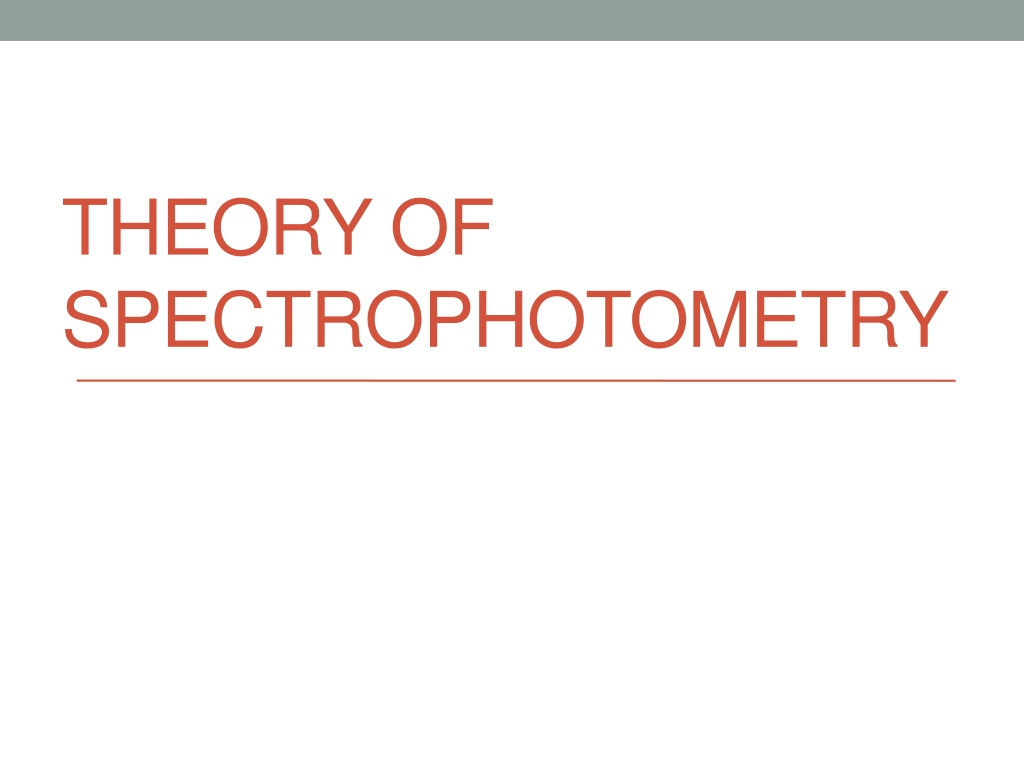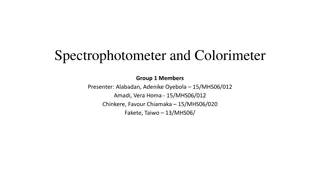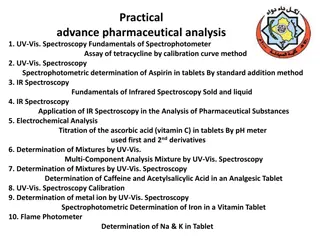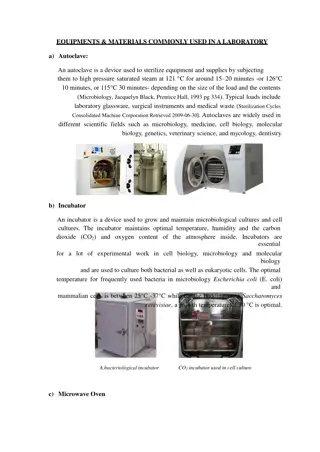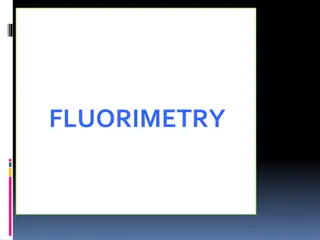Understanding Spectrophotometry: Principles and Applications
Spectrophotometry is a valuable method for measuring the absorption of light by chemical substances, aiding in quantitative analysis in various fields such as chemistry, biochemistry, and clinical applications. This technique involves utilizing spectrophotometers to detect the intensity of light absorbed or transmitted by a sample across different wavelength ranges, with applications ranging from enzyme-catalyzed reactions in biochemistry to clinical diagnosis using blood or tissue samples. Different types of spectrophotometers, such as UV-visible and IR spectrophotometers, cater to specific ranges of electromagnetic radiation for accurate measurements. Visible spectrophotometry, for instance, can determine absorption or transmission by observing the color of the sample, allowing for a wide array of applications in research and analysis.
Download Presentation

Please find below an Image/Link to download the presentation.
The content on the website is provided AS IS for your information and personal use only. It may not be sold, licensed, or shared on other websites without obtaining consent from the author. Download presentation by click this link. If you encounter any issues during the download, it is possible that the publisher has removed the file from their server.
E N D
Presentation Transcript
THEORY OF SPECTROPHOTOMETRY
Spectrophotometry 1 Spectrophotometry is a method to measure how much a chemical substance absorbs light by measuring the intensity of light as a beam of light passes through sample solution. The basic principle is that each compound absorbs or transmits light over a certain range of wavelength. This measurement can also be used to measure the amount of a known chemical substance. Spectrophotometry is one of the most useful methods of quantitative analysis in various fields such as chemistry, physics, biochemistry, material and chemical engineering and clinical applications.
Spectrophotometry 2 Every chemical compound absorbs, transmits, or reflects light (electromagnetic radiation) over a certain range of wavelength Any application that deals with chemical substances or materials can use this technique. In biochemistry, for example, it is used to determine enzyme-catalyzed reactions. In clinical applications, it is used to examine blood or tissues for clinical diagnosis. There are also several variations of the spectrophotometry such as atomic absorption spectrophotometry and atomic emission spectrophotometry.
Spectrophotometry 3 A spectrophotometer is an instrument that measures the amount of photons (the intensity of light) absorbed after it passes through sample solution. With the spectrophotometer, the amount of a known chemical substance (concentrations) can also be determined by measuring the intensity of light detected. Depending on the range of wavelength of light source, it can be classified into two different types: UV-visible spectrophotometer: uses light over the ultraviolet range (185 - 400 nm) and visible range (400 - 700 nm) of electromagnetic radiation spectrum. IR spectrophotometer: uses light over the infrared range (700 - 15000 nm) of electromagnetic radiation spectrum.
Spectrophotometry 4 In visible spectrophotometry, the absorption or the transmission of a certain substance can be determined by the observed color. For instance, a solution sample that absorbs light over all visible ranges (i.e., transmits none of visible wavelengths) appears black in theory. On the other hand, if all visible wavelengths are transmitted (i.e., absorbs nothing), the solution sample appears white. If a solution sample absorbs red light (~700 nm), it appears green because green is the complementary color of red. Visible spectrophotometers, in practice, use a prism to narrow down a certain range of wavelength (to filter out other wavelengths) so that the particular beam of light is passed through a solution sample.
Spectrophotometry Structure The basic structure of spectrophotometers consists of a light source, a collimator, a monochromator, a wavelength selector, a cuvette for sample solution, a photoelectric detector, and a digital display or a meter
Spectrophotometry Devices A spectrophotometer, in general, consists of two devices; a spectrometer and a photometer. A spectrometer is a device that produces, typically disperses and measures light. A photometer indicates the photoelectric detector that measures the intensity of light. Spectrometer: It produces a desired range of wavelength of light. First a collimator (lens) transmits a straight beam of light (photons) that passes through a monochromator (prism) to split it into several component wavelengths (spectrum). Then a wavelength selector (slit) transmits only the desired wavelengths. Photometer: After the desired range of wavelength of light passes through the solution of a sample in cuvette, the photometer detects the amount of photons that is absorbed and then sends a signal to a galvanometer or a digital display.
Absorption Spectra Example You need a spectrometer to produce a variety of wavelengths because different compounds absorb best at different wavelengths. For example, p- nitrophenol (acid form) has the maximum absorbance at approximately 320 nm and p-nitrophenolate (basic form) absorb best at 400nm, as shown below.
Transmittance vs Absorbance The amount of photons that goes through the cuvette and into the detector is dependent on the length of the cuvette and the concentration of the sample. Once you know the intensity of light after it passes through the cuvette, you can relate it to transmittance (T). Transmittance is the fraction of light that passes through the sample. This can be calculated using the equation: Transmittance(T)=It/Io Where Itis the light intensity after the beam of light passes through the cuvette and Iois the light intensity before the beam of light passes through the cuvette. Transmittance is related to absorption by the expression: Absorbance(A)= log(T)= log(It/Io)
Light Transmittance Where absorbance stands for the amount of photons that is absorbed. With the amount of absorbance known from the above equation, you can determine the unknown concentration of the sample by using Beer- Lambert Law. Figure 5 illustrates transmittance of light through a sample. The length l is used for Beer-Lambert Law described below.
Beer-Lambert Law Beer-Lambert Law (also known as Beer's Law) states that there is a linear relationship between the absorbance and the concentration of a sample. For this reason, Beer's Law can only be applied when there is a linear relationship. Beer's Law is written as: A= lc A =measure of absorbance (no units) =molar extinction coefficient or molar absorptivity (absorption coefficient), l =path length, and c =concentration The molar extinction coefficient is given as a constant and varies for each molecule. Since absorbance does not carry any units, the units for must cancel out the units of length and concentration. As a result, has the units: L mol-1 cm-1. The path length is measured in centimeters. Because a standard spectrometer uses a cuvette that is 1 cm in width, l is always assumed to equal 1 cm.
Beer-Lambert Law Example Since absorption, , and path length are known, we can calculate the concentration c of the sample. Example 1 Guanosine nm. 275=8400M 1cm 1 and the path length is 1 cm. Using a spectrophotometer, you find the that A275=0.70. concentration of guanosine? SOLUTION To solve this problem, you must use Beer's Law. A= lc 0.70 = (8400 M-1cm-1)(1 cm)(c) Next, divide both side by [(8400 M-1cm-1)(1 cm)] c = 8.33x10-5mol/L Example 1 Source: Link Source has a maximum absorbance of 275 What is the
Standard Curve A standard curve is a type of graph used as a quantitative research technique. Multiple samples with known properties are measured and graphed, which then allows the same properties to be determined for unknown samples by interpolation on the graph. The samples with known properties are the standards, and the graph is the standard curve. Standard curves are most commonly used to determine the concentration of a substance such as protein or DNA. For example, a standard curve for protein concentration is often created using known concentrations bovine serum albumen. The property measured may be absorbance, optical density, luminescence,fluorescence, radioactivity, or other parameters.
Example Bradford Assay Standard Curve Data for known concentrations of protein are used to make the standard curve, plotting concentration on the X axis, and the assay measurement on the Y axis. The same assay is then performed with samples of unknown concentration. To analyze the data, one locates the measurement on the Y-axis that corresponds to the assay measurement of the unknown substance and follows a line to intersect the standard curve. The corresponding value on the X-axis is the concentration of substance in the unknown sample. An example of a standard curve showing the absorbance of different concentrations of protein (two trials for each measurement). The concentration of protein in a different sample is determined by determining where on the standard curve it should go - in this case, 30 milligrams.
Spectrophotometer Aspectrophotometer is employed to measure the amount of light that a sample absorbs. The instrument operates by passing a beam of light through a sample and measuring the intensity of light reaching a detector. The beam of light consists of a stream of photons, When a photon encounters an analyte molecule (the analyte is the molecule being studied), there is a chance the analyte will absorb the photon. This absorption reduces the number of photons in the beam of light, thereby reducing the intensity of the light beam.
Spectrophotometer light pathway First, the intensity of light (I0) passing through a blank is measured. The intensity is the number of photons per second. The blank is a solution that is identical to the sample solution except that the blank does not contain the solute that absorbs light. This measurement is necessary, because the cell itself scatters some of the light. Second, the intensity of light (I) passing through the sample solution is measured. (In practice, instruments measure the power rather than the intensity of the light. The power is the energy per second, which is the product of the intensity (photons per second) and the energy per photon.) Third, the experimental data is used to calculate two quantities: the transmittance (T) and the absorbance (A). A = - log10T The transmittance is simply the fraction of light in the original beam that passes through the sample and reaches the detector. The remainder of the light, 1 - T, is the fraction of the light absorbed by the sample. (Do not confuse the transmittance with the temperature, which often is given the symbol T.)
Light Absorbance Percentages In most applications, one wishes to relate the amount of light absorbed to the concentration of the absorbing molecule. It turns out that the absorbance rather than the transmittance is most useful for this purpose. If no light is absorbed, the absorbance is zero (100% transmittance). Each unit in absorbance corresponds with an order of magnitude in the fraction of light transmitted. For A = 1, 10% of the light is transmitted (T = 0.10) and 90% is absorbed by the sample. For A = 2, 1% of the light is transmitted and 99% is absorbed. For A = 3, 0.1% of the light is transmitted and 99.9% is absorbed. Link: http://www.chm.davidson.edu/vce/Spectrophotometry/Spe ctrophotometry.html
Lambert Beers Law Lambert Beer's law is a mathematical means of expressing how light is absorbed by matter. The law states that the amount of light emerging from a sample is diminished by three physical phenomena: 1. The amount of absorbing material in its pathlength (concentration) 2. The distance the light must travel through the sample (optical pathlength OPL) 3. The probability that the photon of that particular wavelength will be absorbed by the material (absorptivity or extinction coefficient)
